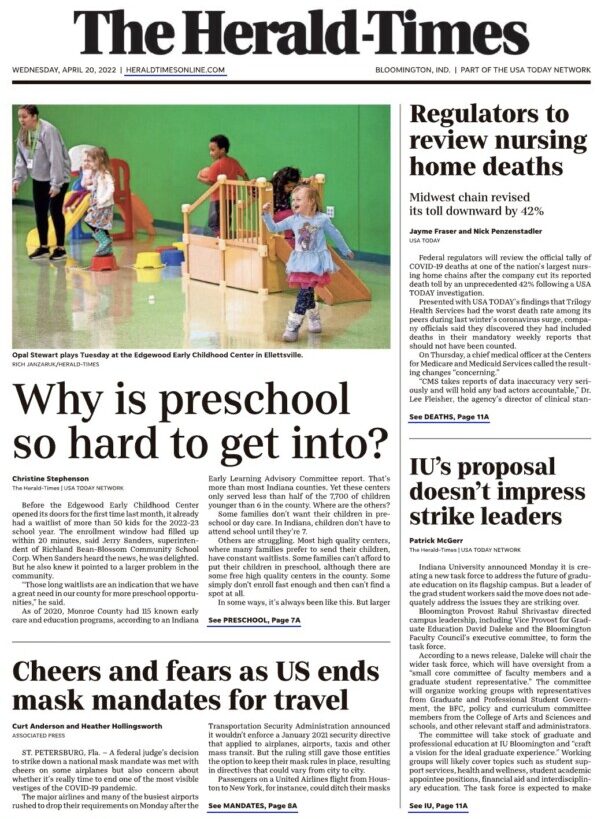The Bloomington Herald-Times reached out to us at Monroe Smart Start to learn more about local childcare and early learning programs and why many currently have long waitlists. What follows is the Herald-Times article published April 20, 2022. We would like to thank the H-T for connecting with us on this important issue and we hope you will find it helpful. If you would like more information, please contact us.
Why is preschool so hard to get into?

Before the Edgewood Early Childhood Center opened its doors for the first time last month, it already had a waitlist of more than 50 kids for the 2022-23 school year.
The enrollment window had filled up within 20 minutes, said Jerry Sanders, superintendent of Richland Bean-Blossom Community School Corp.
When Sanders heard the news, he was delighted. But he also knew it pointed to a larger problem in the community.
“Those long waitlists are an indication that we have a great need in our county for more preschool opportunities,” he said.
As of 2020, Monroe County had 115 known early care and education programs, according to an Indiana Early Learning Advisory Committee report. That’s more than most Indiana counties. Yet these centers only served less than half of the 7,700 of children younger than 6 in the county. Where are the others?
Some families don’t want their children in preschool or day care. In Indiana, children don’t have to attend school until they’re 7.
Others are struggling. Most high quality centers, where many families prefer to send their children, have constant waitlists. Some families can’t afford to put their children in preschool, although there are some free high quality centers in the county. Some simply don’t enroll fast enough and then can’t find a spot at all.
In some ways, it’s always been like this. But larger issues, such as the statewide teacher shortage and the COVID-19 pandemic, have made it worse.
What do preschools and daycares in Monroe County look like?
Of the 115 known early care and education locations in the county, 53 are family child care homes, where caregivers look after children in a residential building. The others are centers, preschools and Head Start programs. Some places, such as The Nest at New Hope, specifically provide early child care and education to underserved populations in Bloomington. New Hope, which opened a new campus this month, will be able to serve about 45 new families.
Some child care centers are not included in state data because they are unlicensed or are already associated with an accredited school, such as Lighthouse Christian Academy. In Indiana, a family child care home can be unlicensed if it cares for five children or fewer.
Each licensed center is rated by the state using a system called Paths to Quality. A Level 1 center indicates the health and safety needs of children are met; Level 2 indicates the center also supports children’s learning; Level 3 indicates the center has a planned curriculum; Level 4, the highest level, means the center is nationally accredited in addition to meeting the other three criteria.
Monroe County has 42 early childhood programs that are considered high quality, or ranked a Level 3 or 4.
Some centers, such as those in R-BB and the Monroe County Community School Corp., typically have waitlists because they are high quality and often convenient for families with older children attending schools in those districts, said Jennifer Myers, Monroe Smart Start’s program coordinator. Monroe Smart Start is an initiative through the Community Foundation of Bloomington and Monroe County to increase and improve local child care and education.
Centers with lower ratings don’t have waitlists as often, but some families don’t want to send their children there, Myers said.
“We do have a lot of choices, and that’s great, but we don’t always have the best choice for families,” she said.
R-BB’s new preschool, which cares for kids age 3 and older, has 92 students this school year. Preschool students were previously housed in Edgewood Primary School.
The corporation plans to use school bonds to build a larger preschool facility in the coming years, but the new facility is filling a need in the meantime, Sanders said.
The new building is intentionally attached to Edgewood Primary School so the preschoolers can watch and learn from the kindergartners and be more prepared to enter kindergarten themselves, Sanders said.
“When children start kindergarten, they’re starting the biggest race of their life,” he said. “And preschool is a great way to provide students with that great start to kindergarten.”
The MCCSC has 12 school-based preschools that also commonly have waitlists, said Debra Prenkert, MCCSC’s director of elementary education. This month, all 12 preschools were named Level 4 centers. More than 200 preschoolers are enrolled for fall 2022, she said.
COVID-19, teacher shortage hinder access
Access to early child care and education in the county has been a problem for years, Myers said. But the pandemic has pushed the problem to a point she’s never seen before.
Preschools and day cares already have to restrict class sizes because younger children need to be monitored closely, she said. After COVID-19 closed all the centers for part of 2020, many put caps on enrollment, shrinking the class sizes even more. Some centers still haven’t returned to full capacity.
Class size isn’t the main access barrier, though, Myers said. It’s the lack of teachers.
Indiana’s teacher shortage has heavily affected preschool teachers for years. Educating young children is hard work, and the pay is usually low. In Bloomington, lead preschool teachers typically earn a little over $13 an hour, or just over $25,000 a year. Meanwhile, in the MCCSC, first-time kindergarten teachers with bachelor’s degrees earn a starting salary of about $43,000.
“That always comes to the forefront, the shortage of workers,” Myers said. “That drives the access. That drives the waitlists. I mean that right there is the elephant in the room.”
When COVID-19 put preschool teachers out of a job, some found better paying jobs at places such as McDonald’s or Target and never returned to the classroom, Myers said.
The pandemic financially hurt families, too. Many parents lost their jobs or were forced to quit to stay home with their children. Even now that preschools and day cares are open again, poorer families are struggling the most with long waitlists, Myers said.
“Our waitlists are longer than they’ve ever been … among families that need subsidized or free care,” Myers said. “There’s no question we have long waitlists for children who need it the most.”
A few years ago, the Indiana General Assembly established a program called On My Way Pre-K to help low-income families afford early childhood education. At least 280 Monroe County children have attended school through the program since 2018, according to Monroe Smart Start’s data.
On My Way Pre-K enrollment for the 2022-23 school year is currently open. Online applications are available at onmywayprek.org.
Still, not every family can be helped. It’s hard to tell how many families want to put their children in early childhood care but can’t, Myers said, because most families are on multiple waitlists around the county.
“But bottom line,” she said, “we have children that are going unserved.”
What happens when families can’t access preschool?
Through Monroe Smart Start, the county has added around 150 more spots for children in early child care and education centers in recent years. But this still isn’t enough.
“No doubt we don’t have enough seats for every child,” Myers said. “If every single child wanted to go to early childhood care education … they couldn’t.”
This lack of access can lead some families to make risky decisions in times of desperation. Myers said she sees plenty of parents post on Facebook asking anyone — even complete strangers — to watch their child while they go to work.
“I’ve seen an uptick in that to an extreme I’ve never seen before, to a place I’d never ever envisioned we would be,” she said. “If they have to get to work, we see them get creative, and that can be a scary place.”
Some parents who can’t get their kids into preschool or daycare worry they will be developmentally behind by the time they get to kindergarten, Myers said. Children’s brains develop more from birth to age 5 than any other time in their lives, according to the Centers for Disease Control and Prevention.
Thankfully, young children don’t need to be in formalized care to work their brains, Myers said.
“Parents are their child’s first teacher,” she said.
She recommended families involve their young children in conversations and use new vocabulary around them. Reading, singing and playing also play a significant role in helping children learn. Even just going outside to a park can work the same as learning in a classroom, she said.
“You don’t have to go and spend money on toys … when the outdoors offer so many learning opportunities,” she said. Just step outside and engage in conversation. Use rocks, sticks, sand, whatever it is that you find, and there are so many opportunities for great learning and storytelling.”
It’s also important to work with children on simple tasks, such as zipping a backpack and washing their hands, before they enter kindergarten. A full kindergarten ready checklist is available on the Monroe Smart Start website.
For those who want to place their child in formalized care, it’s important to get on a waitlist early and stay on it. Schools often have spots open up throughout the year as families move and change districts.
Families can find child care and education centers in Bloomington at in.gov/fssa/childcarefinder/.
